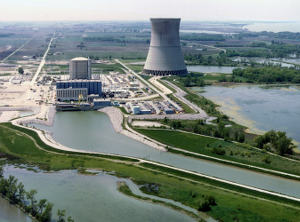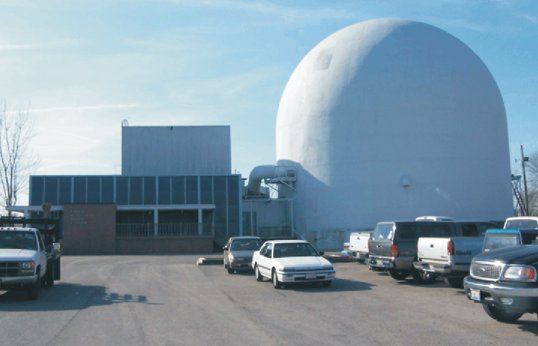Ohio almost had a fourth nuclear power plant. In 1976, Ohio Edison (and partners CEI, Toledo Edison, Duquesne Power & Light, and Pennsylvania Power Company) announced plans to build a two-unit nuclear plant in Berlin Heights, Ohio. It ordered Babcock & Wilcox nuclear steam supply systems – and it ordered the largest available at 1260 MWe each. However, with the need for extra generating capacity rapidly declining, and facing prospects of increasing cost for loans and regulatory uncertainty, Ohio Edison cancelled these plans in 1980 without having performed any work other than obtaining the site, which today is called the Edison Woods Reserve.
 Ohio’s second nuclear power station to be ordered was Davis-Besse; this single unit 900 MWe nuclear plant is located in Oak Harbor Ohio on a nearly 1000 acre site on the shore of Lake Erie, and has been in operation since 1977.
Ohio’s second nuclear power station to be ordered was Davis-Besse; this single unit 900 MWe nuclear plant is located in Oak Harbor Ohio on a nearly 1000 acre site on the shore of Lake Erie, and has been in operation since 1977.
In 1968, Toledo Edison ordered a single Babcock & Wilcox NSSS (nuclear steam supply system) for this site; in 1973, it ordered two more from the same manufacturer. However, construction of these two additional units was never begun and they were officially cancelled in 1981, leaving Davis-Besse as a single-unit nuclear power plant site.
The construction permit for Davis-Besse was issued in 1971; Bechtel Corporation was hired to design the overall power plant, which was completed and given its operating license six years later in 1977. The plant was declared to be in commercial operation in July 1978, and today provides 40 percent of the electric power used in northwestern Ohio.
Image Wikipedia
Thirty-five miles northeast of the city of Cleveland, sited on an 1100 acre tract on the shore of Lake Erie, is the Perry Power Plant – Ohio’s third nuclear plant to be ordered.
In 1971, Cleveland Electric Illuminating and partner companies Toledo Edison, Ohio Edison, Pennsylvania Power and Duquesne Light decided to order a two-unit nuclear plant to be built in Perry, Ohio. The plant would house two General Electric boiling water reactors of high power – each rated at 1205 MWe. The group placed the orders for the units in 1972, hiring Gilbert Associates to design the power plants. Groundbreaking took place in 1974. As construction work continued, power demand forecasts decreased and the decision was made to delay work on Unit 2. By 1988 work at Unit 2 was on hold, with the plant about 45% complete. The decision to cancel Unit 2 was made in 1994. However, the buildings and cooling tower remain intact – so that Perry looks like a two unit site, but only Unit 1 (nearer the lake) actually is an operating plant.
Unit 1 on the other hand finally loaded fuel in March 1986, and completed its 100 hour full-power warranty run on October 24, 1987. Perry Power Plant Unit 1 was declared fully commercial on November 18, 1987 and today is the most powerful single generating unit in the entire FirstEnergy fleet, with a rated 1260 MWe generating capacity after uprates over the years.
The National Institute of Urban Wildlife has certified Perry’s site as an official Urban Wildlife Sanctuary.
 The first nuclear power plant in Ohio was built as a part of the US Atomic Energy Commission’s “Power Demonstration Reactor Program,” which included construction of a reactor by the AEC at a municipal site, with the steam plant equipment supplied by the local utility.
The first nuclear power plant in Ohio was built as a part of the US Atomic Energy Commission’s “Power Demonstration Reactor Program,” which included construction of a reactor by the AEC at a municipal site, with the steam plant equipment supplied by the local utility.
Construction of the PNPF or Piqua Nuclear Power Facility was begun with an official groundbreaking on July 6, 1959. The reactor was built by Atomics International and was contractually owned by the AEC for five years; the Piqua Municipal Power District would buy steam from the AEC reactor to supply its original powerhouse under contract. The City of Piqua supplied operators for the plant, who were trained initially on a prototype reactor of similar type in Idaho.
PNPF was unique among the world’s power reactors in using an organic compound as its coolant. “Santowax OMP,” a commercially available aromatic hydrocarbon in the benzene family, was used for the coolant because it possessed important advantages over water – for example, it did not require high pressure, and it did not interact with most metals. Thus, the nuclear plant could be constructed out of thinner and less exotic materials more common to the petroleum industry than to the nuclear industry.
The reactor first achieved criticality in 1963 and operated fairly successfully for several years, providing the city with the advantage of reducing coal use at its plant which was right in the heart of the community of 20,000 people. The reactor itself was rated at 45 MWt (megawatts thermal) and provided a maximum of 150,000 lbs. per hour of steam at 550F and 430 lbs. pressure to the original municipal power building, where it generated up to 11.4 MWe (megawatts electrical) of power for the municipal system. This was about half of the peak demand of the entire system.
After several years of operation, the reactor encountered technical difficulties and was shut down in January 1966 for investigation and modification. While Atomics International was convinced that these had been solved and was prepared to assist in restarting the reactor, but in March 1967 the AEC decided to drop its organic cooled reactor research program, and in December 1967 announced it was terminating the Piqua contract. The AEC then entered a phase of decommissioning of the plant, removing the fuel and most of the equipment throughout the reactor building and support building through 1969. Today, the two buildings still stand, with the plant officially in “SAFSTOR” status until it is eventually completely dismantled sometime in the future – perhaps around the year 2088. The Department of Energy monitors the integrity of the site on a continuing basis; the site is now used by the city for vehicle parking and storage.
(Thanks to the City of Piqua Ohio and Piqua Municipal Power System for information and assistance.)
